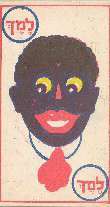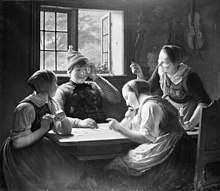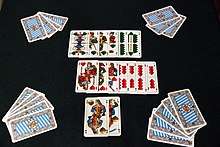Black Peter (card game)
Black Peter is the English name of the European game of Schwarzer Peter which originated in Germany where, along with Quartett, it is one of the most common children's card games.
| Popular European children's game | |
 An historical Black Peter card | |
| Origin | Germany |
|---|---|
| Alternative name | Schwarzer Peter |
| Type | Shedding |
| Players | 3 or more |
| Age range | 6+ |
| Cards | 31 or 37 |
| Deck | Special or standard packs |
| Play | Clockwise |
| Playing time | 5-10 minutes |
| Random chance | Easy |
| Related games | |
| Old Maid, Vieux Garçon | |
Origin of the name
The name Black Peter may be derived from the robber, Johann Peter Petri, a contemporary and accomplice of Johannes Bückler, the notorious highwayman known as Schinderhannes. Petri also went under the nickname of "Old Black Peter" (der alte Schwarzpeter) or just "Black Peter" (Schwarzer Peter) and is supposed to have invented the game while in prison after 1811.[1][2] However, the origin of the game is probably much older (see below).
Origin
The origin of Black Peter is probably to be found in the game of Old Maid[3] or Vieux Garçon (French for "old boy") or Jackass, which was probably once a simple gambling game in which the aim was to determine a loser who had to pay for the next round of drinks (cf. drinking game).[4] However, it has long been a popular children's game and numerous proprietary packs are produced today aimed at the children's market.
The game employs a pack of 32 French cards, the Queen of Hearts being removed in the case of Old Maid, or one of the Jacks in the case of Vieux Garçon or Jackass. The cards are shuffled, cut and dealt evenly to the players. If a player has one or more pairs, e.g. two Sevens or two Kings, he lays them down face up. If a player has three cards of the same rank, he may discard two of them. The suits play no role. The game is played in the same way as Black Peter. The player who is last in and left holding a single Queen or Jack is the "old maid", "vieux garçon" or "jackass" and would originally have had to pay for the next round.
In older packs, the Black Peter was typically a stylised image of a negro (see illustration); more modern packs use a variety of images such as chimney sweeps, black crows or black cats.
Rules

Special Black Peter packs usually consist of 31 or 37 cards: the 'Black Peter' and 15 or 18 pairs of cards.[5] Instead of proprietary playing cards, a pack of traditional French cards may be used with a Joker as the Black Peter. Any number of players can participate in the game, but at least two. The cards are shuffled and evenly dealt to the players. If a player finds a pair in his hand, i.e. two cards with the same corner sign, he discards them immediately.
Now the card drawing begins: the youngest child, or the child holding the most cards, or the player to the left of the dealer, draws a card from the player to his left and adds it to his hand. If he can form a pair with this new card, he discards it. Then it is the turn of the player on the left to play in the same way. In this way, the game continues until all pairs are discarded and one player is left with Black Peter as the only card. This player is Black Peter and receives the agreed 'penalty', such as a black dot on his forehead, nose or cheek.[6]
Variants with a Skat pack
You use a Skat pack of 32 French or German-suited cards. The cards of the same value and suit (black or red) form a pair. One card is removed so that this pair is no longer complete. The remaining card is the Black Peter. The removed card can be revealed, but does not have to be. Now the card drawing begins, see above.
Names in other countries
Italian children play Asinello ("little donkey"). In Sweden the game is called Svarte Petter, while in the Netherlands it is known as Zwarte Piet. However, there it is the same name as Saint Nicholas', helper, a character similar to Knecht Ruprecht or Krampus in German-speaking regions.
Saying
The German saying "jemandem den Schwarzen Peter zuschieben" ("to pass the Black Peter to someone") means to pass the buck, to blame or to dump something inconvenient such as an unwelcome problem or responsibility on another person.[7]
References
- "Grafen, Gold und Schwarzer Peter". Archived from the original on 22 February 2014. Retrieved 28 September 2019. at veldenz.de
- Probst, Ernst (2010), Der Schwarze Peter – Ein Räuber im Hunsrück und Odenwald (in German), GRIN Verlag, p. 17, ISBN 978-3-638-95142-5
- Chisholm, Hugh, ed. (1911). . Encyclopædia Britannica. 20 (11th ed.). Cambridge University Press. p. 74.
- David Parlett: Oxford Dictionary of Card Games. Oxford University Press, Oxford / New York 1992/96.
- Game Test for the Game: Black Peter.
- Download Ravensburger Game Rules as PDF.
- Wolfgang Fleischer: Phraseologie der deutschen Gegenwartssprache. Bibliographisches Institut, 1982, p. 159.
Rudolf Köster: Eigennamen Im Deutschen Wortschatz: Ein Lexikon. De Gruyter, 2003, p. 137.
Dr. Wort: Mich laust der Affe: Neues aus der Welt der Redewendungen. rororo Verlag, 2012.
Literature
- Ernst Probst (2005), Der Schwarze Peter. Ein Räuber im Hunsrück und Odenwald (in German), Mainz-Kostheim: Probst, ISBN 978-3-936326-39-0
- Der schwarze Peter. Ein Räuber im Hunsrück und Odenwald. CD-ROM for PC and Mac, Probst 2005, ISBN 978-3-936326-40-6.
External links
| Wikimedia Commons has media related to Schwarzer Peter. |
